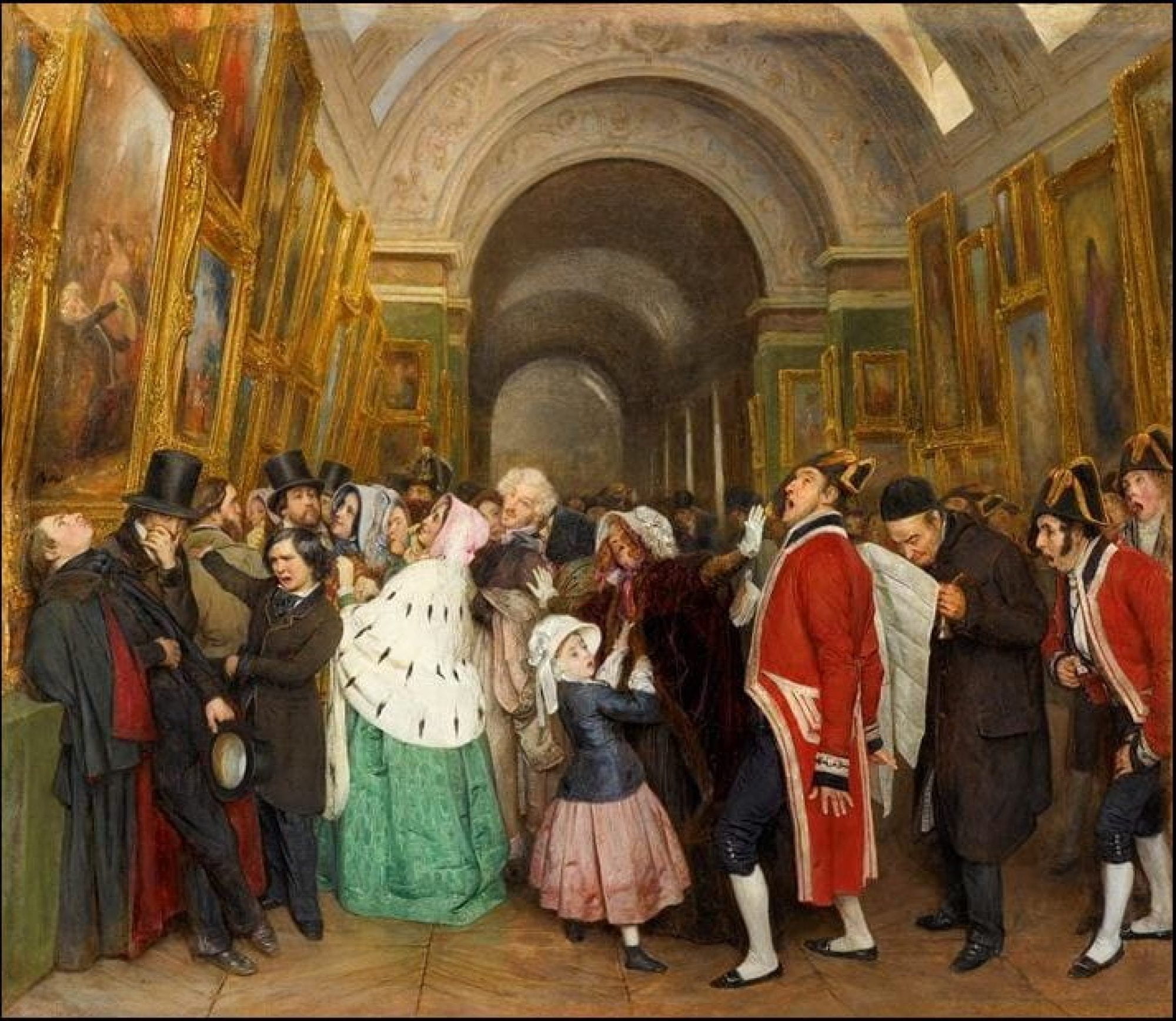Why does art HAVE to be boring?
Walking backpacks, headphones on at all times, the carrying of heavy art supplies, and endless eyebags are all attributes to art students in general, a mood that is visualized in the 2023 Texas State University’s Juried exhibition at the Joan Colle Mitte galleries. As you walk into this gallery you are met with a variety of colors, forms, and mediums, each utilized in a different way. Whether it was the curator’s choice or not, the chaotic mood throughout the exhibition is not a negative aspect but an opportunity for the featured artists to, through their art, expose further aspects of their identity outside of what it means to be an art student at TXST. Furthermore, this exhibition is a fresh and fun way to showcase how the youth of today are pushing the boundaries around the ideas of what contemporary art looks like. My purpose with this exhibition review is to create a greater understanding of how the current youth is pushing boundaries in the art world and creating a newer understanding on how art in the academic world looks like.
As I walked to the left side of the gallery my eyes quickly traveled to the white lamb head which appears to be protruding from the wall. There is something very mysterious about its composition and the artistic choice to have the lamb facing down as it creates a shadow and prohibits the viewer from seeing the details in the lamb’s eyes unless viewed up close and through the left or right angle. This interaction becomes almost mandatory as it is needed for the viewer to create a meaning to what is being seen, adding to the uneasiness of this work of art. The Lamb / A Love Letter by Davin Aldera would be perceived through a completely different perspective if it would have been installed in the “traditional” way we see sculptures displayed in a gallery such as in a platform or standing, like many of the other artworks were installed in this exhibition.
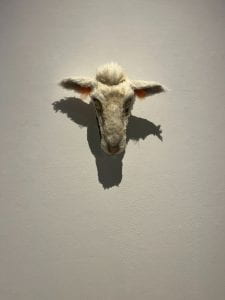
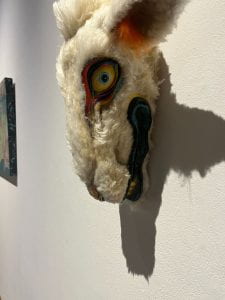
Aldera’s artistic choice to install The Lamb on the gallery’s wall just like a painting on a frame gives the illusion of a taxidermy gone wrong, or that of a nightmare I can’t seem to put a meaning to. Even though The Lamb is sinister, nightmarish, and could not be further from displaying the overall qualities of the evangelical lamb, I could not keep myself from further inspecting it (just like those horror movies where the character screams and stares instead of running). For both the eyes and mouth of the left and right profile, Aldera utilizes ceramic, acrylic paint, and gouache to create colorful layers around the lamb’s eyelids, pupil, and the areas surrounding the eye. Aldera also utilizes the mentioned materials in colors in the rendering of their creation’s nose, mouth, and teeth. Even though Aldera uses vibrant colors and an animal that for so long has be seen as pure and innocent, The Lamb / A Love Letter is still an intimidating composition, and if given horns it would possibly not be too far from being seen as the goats tied to satanism. Aldera’s work of art recalls the religious symbolism of the Lamb of God, as the common sacrificial animal, except this lamb meets us face to face and not as the submissive creatures they are commonly portrayed to be. The Lamb is rebelling against the guidance of the Good Shepperd, one that can survive outside the flock and is not willing to be sacrificed. The Lamb speaks to me as the religious anxiety that has risen in the U.S, as many people of power have used the Bible and Christian beliefs as an excuse to be oppressive and discriminatory. I mean, the rise of oppression as a governmental tool became clear with colonization, and colonization has a root in western religiosity. The Lamb is no longer willing to be used. It is not tied or docile, and it meets us eye to eye like no other composition in this exhibit. Aldera’s work, in my opinion, represents a younger and bigger generation currently making efforts and creating awareness towards decolonizing belief systems (religious or not) and understanding the malicious roots and acts committed in their name. This is materialized in The Lamb / A Love Letter as it forces us to interact with it and face it as it is.
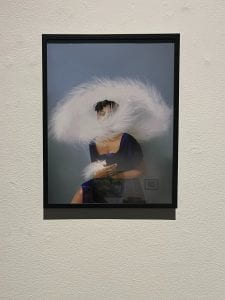
In contrast with the mood that Aldera’s work creates, on its right side, I am met with a much softer composition in the form of a photograph. Deandra Lee’s Alone Blue is both soft and nostalgic. This photograph contains a woman dressed in a blue dress, sitting down with a long white feather that emerges from her back and lays through her head ending its course at her face, touching her face softly, lightly covering it, but leaving most of her eyes untouched as she makes eye contact with the spectator. Her hands are slightly clasped while holding a single feather of the same appearance as the feather mentioned before. Her gaze is lonely, I can’t seem to stop comparing this composition to that of a painting or her pose to that of a person that’s being painted. Her mouth is covered almost completely, seeming to be in an act of “muting” her. But the woman in this painting seems to have the autonomy to remove this feather as she herself is holding one, and feathers are not a heavy material, nor one that is perceived as constraining. So, is this silence an autonomous decision, or something out of her own reach? This composition also has a beautiful and feminine aspect to it which is attributed to Lee’s artistic choice of using royal blue and white as the main colors in this photograph. Furthermore, the use of feathers, a symbol of softness, further creates a possible theme in this work of art. It bides the question: Can the act of femininity and softness be constraining? Lonely?
What makes this exhibition memorable and important are the intimate aspects of the art pieces showcased. As artists in academic exhibitions, the “classical” skills and elements in artworks are celebrated but individuality tends to be viewed as unskilled and not supported, often like an extracurricular activity rather than part of an artist’s academic endeavors. This is not to be misunderstood as saying that young artists don’t utilize classical art elements, but that this exhibition supports originality and therefore brings a fresh, new look on what artistic elements newer generations are gearing towards. Furthermore, it opens the audience’s awareness to what TXST’s artists are choosing to create outside of academic assignments and what is part of a set art curriculum.
The Lamb and Alone Blue are both artworks that bring intimate themes to this exhibition and the audience’s mind, these themes ranging from religion to loneliness and femininity. But artists at TXST are diverse in all aspects, from intimate artworks to pop art and artists that make clear references to Gen Z culture, there was not a moment in this exhibition where I found myself bored. This concept could have been amplified if the curators and other staff working on the exhibition would have given the viewers more information about the artists, such as their artist bio or just a short description of the artist that could amplify the concept of this exhibition. It is understandable to not want to have any other information relating to the artwork, other than the artist’s name and materials used, to prevent interference with the messages of the artwork; but I believe this could’ve been beneficial in creating more context and giving artists credit, creating an avenue for these artists to express themselves through something other than their artwork, an opportunity that is usually not given to student artists.
Gen z’s love Hello Kitty, I mean almost a great part of every generation, after Yuko Shimuzu released our beloved character in 1974, has loved Hello Kitty and Friends. She is a symbol of childhood, friendship, cuteness, and fun. Even when Hello Kitty originally was seen as a brand for kids, now she is seen everywhere thanks to newer generations. We see Hello Kitty in adult skincare, makeup, memes, clothes and practically anything else you can think of. So, it wasn’t a surprise to see her in this exhibition full of young artists. Drew Mcdonald portrayed the collective sentiment towards Hello Kitty on their intimate canvases My Obsession and The Yee to my Haw. Through a skillful use of shadow, Mcdonald transformed the 2D material of the canvases into almost 3D images of Hello Kitty as she stands on these mini canvases and greets us face to face.
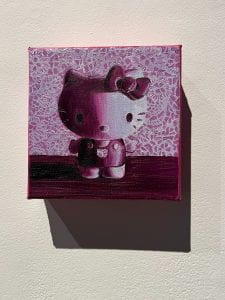
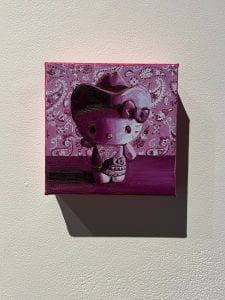
My Obsession is our usual nostalgic image of Hello Kitty, smiling without a mouth and her known big bow. But she still is rather different in this artwork as Mcdonald, through the use of color, creates a purple filter over these two oil paintings. This design choice makes these representations of Hello Kitty even more nostalgic, like a faded memory. Besides it, The Yee to my Haw is a Texan transformation of Hello Kitty as she is depicted wearing known western symbols of the south such as western boots, bandanas, and a cowboy hat (still not losing her bow). Hello Kitty is a symbol of youth as a collective, so she is often transformed to fit the identity of the person altering her, as we see Mcdonald do in this artwork. These two art pieces are a clear reference to pop culture and what is trendy while still being skillful, something that art critics for long have condemned, especially if you are an emerging young artist.
Mcdonald and other artists in the Texas State Juried Exhibition are clear examples that art doesn’t have to be boring and repetitive to be academic recognition and being showcased in a known art institution. Artists in this exhibition are a reminder that they should not have popular or favored in the art industry to have the freedom to make fun, flirty, controversial, and defying art or at least struggled so much to be recognized just because the art is not following century old rules on how art needs to be produced.
Exhibitions need to be more of what I have just experienced, art that doesn’t bore you, art that you can recognize yourself in. Art in which you can experience the terrifying feeling that sometimes creeps in as you unlearn set ideals, art where you can see the feeling of loneliness personified or art that your inner child experiences joy in.
Everybody should see this exhibition. Not because I say so or because this highly opinionated essay, but because young artists are our opportunity to push rigid boundaries around art. We love to say, “ART CAN BE ANYTHING!”, but does the art industry believe this? Original and “non-classical” art is always harder to get funded and recognized as art compared to art that follows predetermined rules on how art should look like. And Artists need to get paid. Young diverse artists need to be recognized. Old ideas, eventually, always die and we need new artists to create new ones. Young artists are our key to a future of provocative and lively art and this exhibition is a small but impactful portion of how that would look like.
